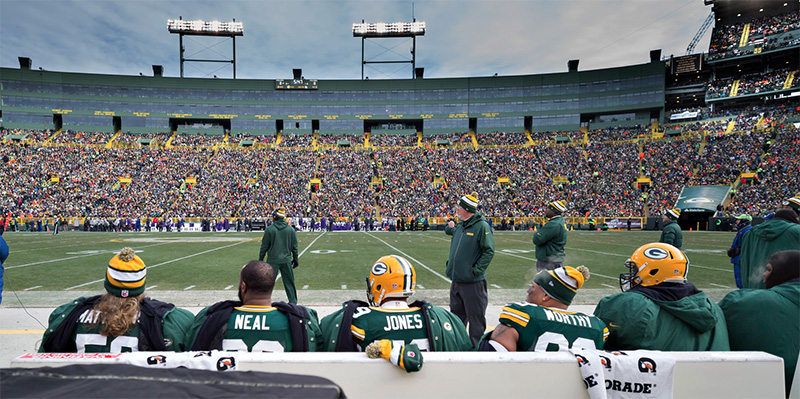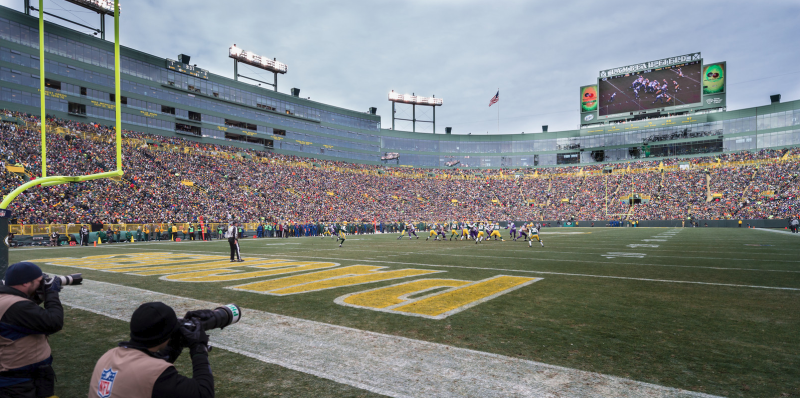 Note that most players don't let their insulating capes come between
Note that most players don't let their insulating capes come between
their bodies and the heated bench.
-
Words and photographs by Jack MacDonough
Today—Sunday—most football fans will wonder about the players or the fans in the cold. Not me. I think of the sports photographers in the cold.
I was at the Packers-Viking game in late November when it was 22°F warm. I learned that as long as the wind is not a factor, the field is not as cold as I expected.
1. The field is heated via underground pipes. So it is surprisingly warmer than the air. Your feet won't get as cold as expected.
2. The player bench is also well heated. When players sit on it, they wear their capes like blankets so they sit directly in contact with the bench.
3. Those capes are like insulated tents and amazingly effective in warding off the cold. I know because I purchased a few used ones a few years ago for watching in the seats.
I could not wear my Packers cape because a "field photographer" is required to wear an identifying vest that has "FIELD PHOTO" on the back, and the cape would have hidden that vest. The vest is the equivalent of an all-access pass (a vest that says NFL FILMS is even better). Even though my vest says "field," I am not allowed on the actual playing field. Only players and referees can be there. There is a yellow line all around the field that a photographer must not cross. It's about a yard back from where the participants can stand, and behind the bench. That does not mean the players don't crash over the yellow line and crush photographers occasionally, so you must stay alert for your own safety.
 Unidentified photographer working the Packers-Vikings game, dressed for moderate cold. Note the all-important yellow line.
Unidentified photographer working the Packers-Vikings game, dressed for moderate cold. Note the all-important yellow line.
The other field photographers were not overly dressed for the cold because they move a lot which generates heat. I was dressed for an even colder day and actually overheated after moving around. Consuming water is important for a working photographer, as I ended up sweating, not shivering.
I asked a few fellow photographers what their key cold weather equipment was, and their answer was backup batteries kept close to their warm bodies. One had a backup pair of gloves kept in a pocket next to hand warmers. He switched back and forth between the two pair of gloves. Pretty useful idea. Incidentally, 70,000 hand warmers will be given away later today to the fans at the Packers-49ers playoff game.
The new South End Zone superstructure
Many photographers used knee pads which not only protect knees when on the ground, but add insulation from the ground. Very long, fast, heavy lenses abound, and most everyone uses monopods. Usually photographers had a second camera for wide angle shots. No one switches lenses. There is no time, and it invites dust or snow on sensors, and it can be dangerous to be concentrating on your equipment when a lineman is rolling toward you.
So you have in some cases twenty pounds of equipment you are lugging around, and that exertion will generate heat. If your face is not too exposed and you have good gloves you will be OK. The switch from film to digital is a huge plus—in the past, changing film often required taking gloves off. Since the field is heated, as mentioned, I found my feet didn't get cold as they do when I sit in the stands with my boots on sub-zero concrete. Again, moving around carrying gear is different than just sitting. And to get the best shots you will be moving around a bit. You have to anticipate how a play might develop. Even with high speed motor drives and autofocus, you need planning, experience, and luck.
One final tip from another photographer was, don't breathe on your lenses as your breath will freeze on the glass. You won't get it clear until half-time when you can go into the warm media room near the locker rooms.
 Photographers at work in the end zone. Note the obligatory vests.
Photographers at work in the end zone. Note the obligatory vests.
It was a fun photography experience for an architecture and landscape art photographer. But it was a relatively warm 22°F when I was there. I won't be doing it today in temperatures expected to be near zero by game time. However, my experience gave me an appreciation for how challenging it is to be a sports photographer.
Jack
Jack MacDonough is an architecture and landscape fine art photographer who specializes in large-sized photographic installations for corporate and individual clients throughout the United States. He had a field pass because the Green Bay Packers organization asked him to photograph the architecture of Lambeau Field's new stadium addition from the on-field perspective.
©2014 by John N. MacDonough, all rights reserved
Links in this post may be to our affiliates; sales through affiliate links may benefit this site.
(To see all the comments, click on the "Comments" link below.)
Featured Comments from:
DAvid Seelig: "As someone who shoots NFL games, we who just have 400mm lenses will put off and on tele-extenders in all weather. The equivalent of changing lenses. Also, many guys, when end zone plays are coming up, will change lenses if they only have two bodies."




